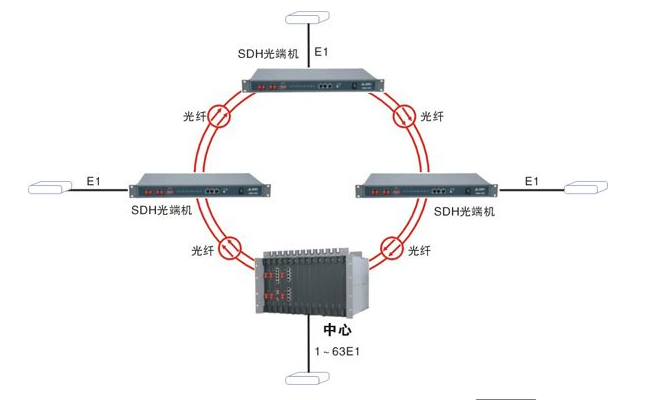Modular integrated transmission optical transceiver optical transceiver is the terminal equipment for optical signal transmission. Due to the improvement of the current technology, the reduction of the price of optical fiber has made it a good application in various fields, so the manufacturers of optical transceivers have been mushrooming. However, most of the manufacturers here are not fully mature. The development of new technologies requires cost, manpower and material resources. This has resulted in manufacturers being mostly small and medium-sized enterprises, and various brands have emerged. However, the quality is still similar. Foreign optical transceivers are good but expensive. Therefore, domestic manufacturers have transformed the production of optical transceivers to meet domestic needs.
classification
PDH optical transceiver
SDH optical transceiver
SPDH optical transceiver
concept
In remote optical fiber transmission, the optical cable has little effect on the transmission of the signal. The transmission quality of the optical transmission system mainly depends on the quality of the optical transceiver. Because the optical transceiver is responsible for photoelectric conversion and light emission and light reception, its advantages and disadvantages directly affect the entire system.

The following small series will explain the overview and technical application of SDH optical transceiver in detail.
The SDH optical transceiver has a large capacity, generally 4E1 to 252E1. SDH is a comprehensive information transmission network that integrates multiplexing, line transmission and switching functions and is operated by a unified network management system. It is a synchronous optical network (SONET) proposed by the Bell Communications Technology Institute of the United States.
The International Telegraph and Telephone Consultative Committee (CCITT) (now ITU-T) accepted the SONET concept in 1988 and renamed it SDH, making it a general-purpose technology not only for fiber but also for microwave and satellite transmission. It can realize effective network management, real-time service monitoring, dynamic network maintenance, and interoperability between devices of different vendors. It can greatly improve network resource utilization, reduce management and maintenance costs, and achieve flexible, reliable and efficient network operation and maintenance. Therefore, it is a hot spot in the development and application of transmission technology in the information field of today's world.
SDH optical transceiver overviewThe SDH optical transceiver has a large capacity, generally 4E1 to 252E1. SDH is a comprehensive information transmission network that integrates multiplexing, line transmission and switching functions and is operated by a unified network management system. It is a synchronous optical network (SONET) proposed by the Bell Communications Technology Institute of the United States. The International Telegraph and Telephone Consultative Committee (CCITT) (now ITU-T) accepted the SONET concept in 1988 and renamed it SDH, making it a general-purpose technology not only for fiber but also for microwave and satellite transmission. It can realize effective network management, real-time service monitoring, dynamic network maintenance, and interoperability between devices of different vendors. It can greatly improve network resource utilization, reduce management and maintenance costs, and achieve flexible, reliable and efficient network operation and maintenance. Therefore, it is a hot spot in the development and application of transmission technology in the information field of today's world.
SDH optical transceiver technology applicationThe birth of SDH has its inevitability. With the development of communication, the information required to be transmitted is not only voice, but also text, data, images and video. In addition to the development of digital communication and computer technology, in the 1970s and 1980s, T1 (DS1)/E1 carrier systems (1.544/2.048 Mbps), X.25 frame relay, ISDN (Integrated Services Digital Network) and FDDI ( A variety of network technologies such as fiber-optic distributed data interfaces.

With the advent of the information society, people hope that modern information transmission networks can provide various circuits and services quickly, economically and effectively. The above-mentioned network technologies are only in the original due to the monotony of their services, the complexity of expansion, and the limitations of bandwidth. It is useless to modify or improve within the framework. SDH developed in this context. Among various broadband fiber access network technologies, access network systems using SDH technology are the most common applications.
The birth of SDH solved the problem of the backbone network and user service demand due to the bandwidth limitation of the home media, which caused the problem of access bottleneck between the user and the core network, and increased the bandwidth of the transmission network. Utilization. Since the introduction of SDH technology in the 1990s, it has been a mature and standard technology. It is widely used in the backbone network, and the price is getting lower and lower. The application of SDH technology in the access network can bring huge bandwidth in the core network. Advantages and technical advantages are brought into the access network field, making full use of SDH synchronous multiplexing, standardized optical interfaces, powerful network management capabilities, flexible network topology capabilities and high reliability, and benefiting in the development of access networks. .
Usb C Cable is also known as Usb Cable Type C interface,is an interface specification consisting of a Type-C plug and a type-C socket.Its highlights are thinner design,faster transmission speed (up to 10Gbps),stronger power transmission (up to 100W).In addition, USB-C interface also supports double-sided insertion,front and back can be inserted at will, compared with USB2.0/USB3.0 more advanced.Usb-c has been given better media properties,faster transfer speeds,and better compatibility with charging.The new generation USB-C has faster transmission speed than USB,stronger power transmission, smaller interface size,and supports bidirectional transmission with stronger compatibility.
Thinner bodies require thinner ports,which is one of the reasons USB-C is here to stay.The USB-C port is 0.83 cm long and 0.26 cm wide.The old USB port measuring 1.4cm long and 0.65cm wide looks outdated.This also means that the end of USB Cable will be one-third the size of the plug of A standard USB-A cable.The USB-C port is the same on the front and back.This means that no matter how you insert the port,it will be correct.Users do not have to worry about the pros and cons of traditional USB ports.

Usb C Cable,Custom Usb C Cable,Flexible Usb C Cable,Braided Coiled Usb C Cable
Henan Yijiao Trading Co., Ltd , https://www.yjusbhubs.com